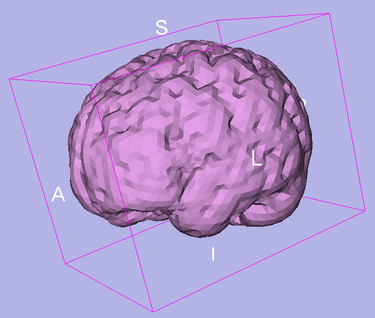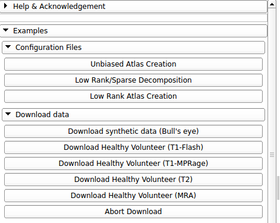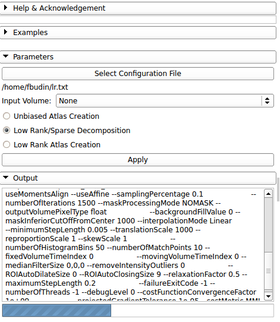Documentation/4.6/Extensions/pyLARSlicerExtension
|
For the latest Slicer documentation, visit the read-the-docs. |
Introduction and Acknowledgements
|
Extension: pyLAR Slicer Extension | |||||||
|
Module Description
Use Cases
Tutorials
Panels and their use
The example panel presents two options:
- Create sample configuration files: They can be edited and adapted to process the researcher's data. Most likely, the file containing the list of images to process (file_list_file_name) will also have to be updated before one runs the algorithm.
- Downloading sample data from http://slicer.kitware.com/midas3 and http://insight-journal.org/midas
- Synthetic data (bull's eye)
- Healthy volunteer (T1-Flash)
- Healthy volunteer (T1-MPRage)
- Healthy volunteer (T2)
- Healthy volunteer (MRA)
The user needs to select a configuration file and the algorithm to run (unbiased atlas creation, low rank/Sparse decomposition, Low Rank Atlas Creation). The user then presses "Apply" and the result will be automatically loaded in Slicer. All the temporary images that were used and computed while the algorithm is running are saved in "result_dir" specified in the configuration file. The researcher can also specify an additional image that is not listed in the file containing the list of images. This image will be added at computation time. This is convenient for example if one needs to compute the Low Rank/Sparse decomposition of subjects one at the time, using a list of healthy control that does not need to be modified.
Configuration files
- Unbiased atlas creation
- clean (boolean): Removes content of output directory before starting computation
- data_dir (string): directory containing 'file_list_file_name'
- file_list_file_name (string): text file containing a list of image file paths, one per line
- verbose (boolean): Displays more or less information while running
- result_dir (string): output directory where outputs will be saved.
- selection (list): select images that are processed in given list [must contain at least 2 values].
- reference_im_fn (string): reference image used for the registration.
- num_of_iterations_per_level (int): Number of iteration per level for the registration [>=0]
- num_of_levels (int): Number of levels (starting the registration at a down-sampled level) for the registration [>=1]
- ants_params (see example and ANTS documentation):
- number_of_cpu (integer/optional): Number of diffeomorphic registration run in parallel. In not specified, it will run as many processes as there are CPU available. Beware, the processes might already be multithreaded.
- Low Rank/Sparse decomposition
- clean (boolean): Removes content of output directory before starting computation
- data_dir (string): directory containing 'file_list_file_name'
- file_list_file_name (string): text file containing a list of image file paths, one per line
- verbose (boolean): Displays more or less information while running
- lamda (float): the tuning parameter that weights between the low-rank component and the sparse component.
- sigma (float): blurring kernel size.
- result_dir (string): output directory where outputs will be saved.
- selection (list): select images that are processed in given list [must contain at least 1 value].
- reference_im_fn (string): reference image used for the registration.
- registration (string): 'affine', 'rigid', or 'none'
- histogram_matching (boolean/optional): If not specified or set to False, no histogram matching performed.
- Low Rank Atlas Creation
- clean (boolean): Removes content of output directory before starting computation
- data_dir (string): directory containing 'file_list_file_name'
- file_list_file_name (string): text file containing a list of image file paths, one per line
- verbose (boolean): Displays more or less information while running
- lamda (float): the tuning parameter that weights between the low-rank component and the sparse component.
- sigma (float): blurring kernel size.
- result_dir (string): output directory where outputs will be saved.
- selection (list): select images that are processed in given list [must contain at least 2 values].
- reference_im_fn (string): reference image used for the registration.
- use_healthy_atlas (boolean): use a specified healthy atlas as reference image or compute a reference image from the average of all the low-ranked images computed from the selected input images.
- num_of_iterations_per_level (int): Number of iteration per level for the registration [>=0]
- num_of_levels (int): Number of levels (starting the registration at a down-sampled level) for the registration [>=1]
- registration_type (string): Type of registration performed, selected among [BSpline,ANTS,Demons]
- ants_params (see example and ANTS documentation): Only necessary if registration_type is set to ANTS.
- number_of_cpu (integer/optional): Number of diffeomorphic registration run in parallel. In not specified, it will run as many processes as there are CPU available. Beware, the processes might already be multithreaded.
- File List File Name: text file containing a list of image file paths, one per line
/path/to/first/image.nrrd /path/to/second/image2.nrrd /path/to/third/image3.nii.gz
References
- Liu et al., "Low-Rank to the Rescue – Atlas-Based Analyses in the Presence of Pathologies", MICCAI 2014, pp97-104
- Liu et al., "Low-Rank Atlas Image Analyses in the Presence of Pathologies", IEEE Transactions on Medical Imaging, Vol. 34, No. 12, December 2015
- Candes et al., "Robust Principal Component Analysis?", Journal of the ACM, Vol. 58, No. 3, 2011
- Lin et al., "The Augmented Lagrangian Multiplier Method for Exact Recovery of Corrupted Low-Rank Matrices", 2011 (available online on archivX)
Information for Developers
| Section under construction. |





